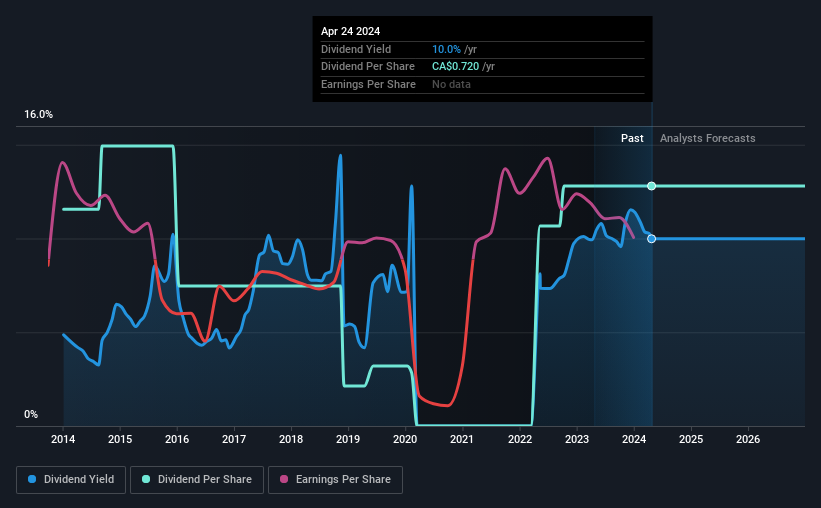Here's Why We're Wary Of Buying Cardinal Energy's (TSE:CJ) For Its Upcoming Dividend
Some investors rely on dividends for growing their wealth, and if you're one of those dividend sleuths, you might be intrigued to know that Cardinal Energy Ltd. (TSE:CJ) is about to go ex-dividend in just 3 days. The ex-dividend date occurs one day before the record date which is the day on which shareholders need to be on the company's books in order to receive a dividend. The ex-dividend date is an important date to be aware of as any purchase of the stock made on or after this date might mean a late settlement that doesn't show on the record date. Accordingly, Cardinal Energy investors that purchase the stock on or after the 29th of April will not receive the dividend, which will be paid on the 15th of May.
The company's next dividend payment will be CA$0.06 per share, on the back of last year when the company paid a total of CA$0.72 to shareholders. Looking at the last 12 months of distributions, Cardinal Energy has a trailing yield of approximately 10.0% on its current stock price of CA$7.21. If you buy this business for its dividend, you should have an idea of whether Cardinal Energy's dividend is reliable and sustainable. That's why we should always check whether the dividend payments appear sustainable, and if the company is growing.
View our latest analysis for Cardinal Energy
Dividends are usually paid out of company profits, so if a company pays out more than it earned then its dividend is usually at greater risk of being cut. Last year Cardinal Energy paid out 110% of its profits as dividends to shareholders, suggesting the dividend is not well covered by earnings. A useful secondary check can be to evaluate whether Cardinal Energy generated enough free cash flow to afford its dividend. Over the past year it paid out 120% of its free cash flow as dividends, which is uncomfortably high. It's hard to consistently pay out more cash than you generate without either borrowing or using company cash, so we'd wonder how the company justifies this payout level.
As Cardinal Energy's dividend was not well covered by either earnings or cash flow, we would be concerned that this dividend could be at risk over the long term.
Click here to see the company's payout ratio, plus analyst estimates of its future dividends.
Have Earnings And Dividends Been Growing?
Companies with consistently growing earnings per share generally make the best dividend stocks, as they usually find it easier to grow dividends per share. Investors love dividends, so if earnings fall and the dividend is reduced, expect a stock to be sold off heavily at the same time. This is why it's a relief to see Cardinal Energy earnings per share are up 4.4% per annum over the last five years. Minimal earnings growth, combined with concerningly high payout ratios suggests that Cardinal Energy is unlikely to grow the dividend much in future, and indeed the payment could be vulnerable to a cut.
The main way most investors will assess a company's dividend prospects is by checking the historical rate of dividend growth. In the past 10 years, Cardinal Energy has increased its dividend at approximately 1.0% a year on average.
To Sum It Up
Is Cardinal Energy an attractive dividend stock, or better left on the shelf? Cardinal Energy is paying out an uncomfortably high percentage of both earnings and cash flow as dividends, although at least earnings per share are growing somewhat. Overall it doesn't look like the most suitable dividend stock for a long-term buy and hold investor.
Having said that, if you're looking at this stock without much concern for the dividend, you should still be familiar of the risks involved with Cardinal Energy. We've identified 2 warning signs with Cardinal Energy (at least 1 which is a bit unpleasant), and understanding them should be part of your investment process.
If you're in the market for strong dividend payers, we recommend checking our selection of top dividend stocks.
Have feedback on this article? Concerned about the content? Get in touch with us directly. Alternatively, email editorial-team (at) simplywallst.com.
This article by Simply Wall St is general in nature. We provide commentary based on historical data and analyst forecasts only using an unbiased methodology and our articles are not intended to be financial advice. It does not constitute a recommendation to buy or sell any stock, and does not take account of your objectives, or your financial situation. We aim to bring you long-term focused analysis driven by fundamental data. Note that our analysis may not factor in the latest price-sensitive company announcements or qualitative material. Simply Wall St has no position in any stocks mentioned.

 Yahoo Finance
Yahoo Finance 
